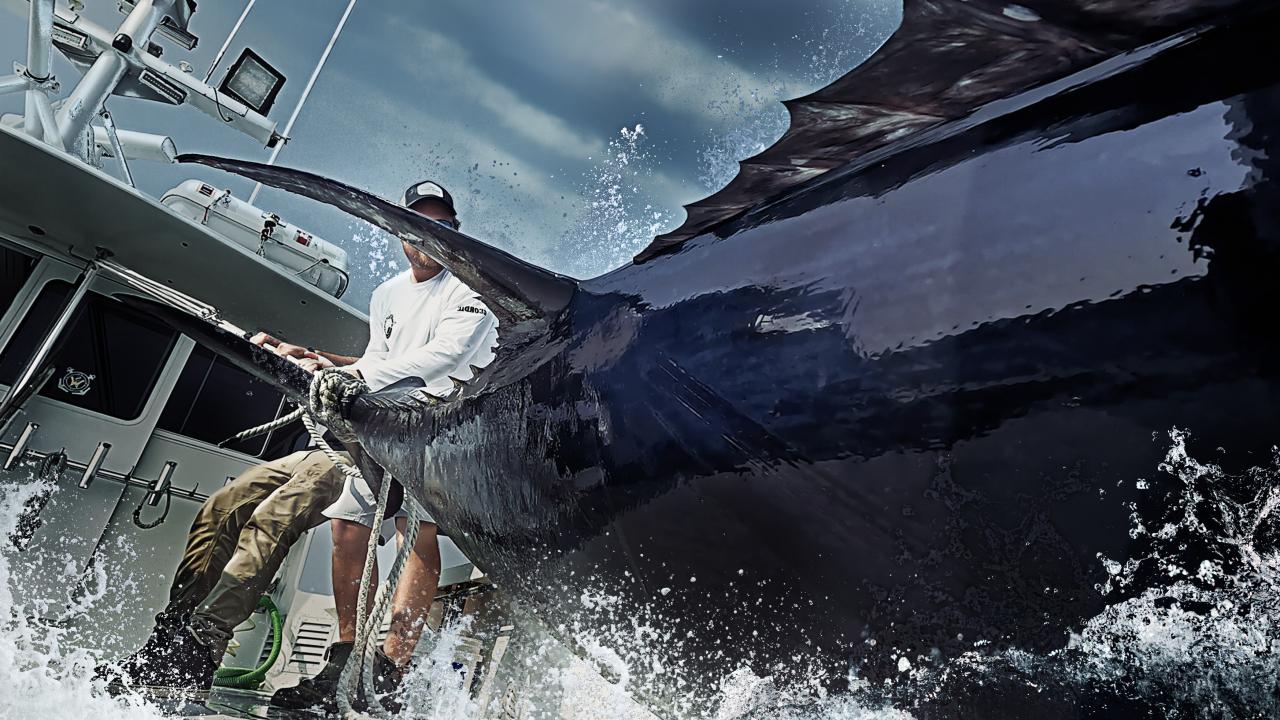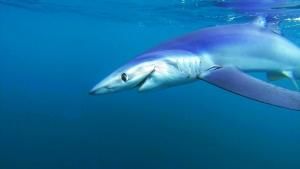- Canada
Americas
Asia & Oceania
Middle East & Africa
Europe
TV SHOWS
SHOWS BY SUBJECT
DON'T MISS
TOP SHOWS
VIDEOS
Don't Miss
Most Viewed
Sharkfest 2024
Show: Sharkfest 2024Sharkfest 2024 Tease
Show: Sharkfest 2024Shark Beach with Anthony Mackie
Show: Shark Beach with Anthony MackieMonkey Hot Tub
Show: Wild Japan: Snow MonkeysTuna Wars
Show: Wicked TunaWicked Tuna S13 Promo
Show: Wicked TunaThe Invaders
Show: Wild Yellowstone: She WolfShipwreck Treasure
Show: Wicked TunaLawless Island S7
Show: Lawless Island
PHOTOS
Photo of the day

WICKED TUNA
- HOME
- ABOUT
- VIDEOS
- PHOTOS
- LOCATION
- INTERACT
- MORE
- Plight of the Bluefin Tuna
- Still Waters: The Global Fish Crisis
- Frequently Asked Questions
- Bluefin Tuna
- Seafood Crisis: Time for a Sea Change
- Wicked Glossary
- Bluefin Tuna 101
- Gloucester: The Fishing Life
- Captain's Q&A
- Rod and Reel: Bluefin Tuna Fishing by the Numbers
- Overfishing
- 10 Things You Can Do to Save the Ocean
- Seafood Substitutions
- Cook Wise Recipes
- Bluefin Tuna Resources
- Bluefin 360
- LEARN ABOUT BLUEFIN TUNA
BLUEFIN 360
The Fate of the Bluefin Tuna
By Patrick J. Kiger
Marine scientist Carl Safina, who grew up fishing the waters off Long Island, first saw an Atlantic bluefin tuna when he hooked one back in 1968. "It wasn't a very big bluefin, but it was the biggest fish I had ever caught," recalls Safina, the co-founder and president of the Blue Ocean Institute at Stony Brook University in New York. "And I was completely awed by it." He was amazed not just by the bluefin's size and power, but its streamlined, efficient body, which allows it to swim at speeds over 40 miles per hour and pursue prey thousands of feet into the ocean depths. It was equally amazing, he recalls, that such an extraordinary animal existed in such great numbers. "In those days, you would run into bluefin pretty much all over the place," he says. "You'd see them, even when you weren't looking for them."
Those days are long gone. The once-prolific Thunnus thynnus, a majestic creature that can reach over ten feet in length and up to a ton in weight, has been swimming the Atlantic for at least the past 40 million years. But today, some fear that the species' days are numbered due to a growing human craving for its fatty, succulent flesh, which is consumed raw as Japanese-style sushi. In the western Atlantic, the bluefin spawning population is now between 21 and 29 percent of what it was in 1970, according to the National Oceanic and Atmospheric Administration's estimate. A study published in 2011 in the scientific journal PLoS ONE concluded that since 1950, the adult bluefin population has declined by 83 percent in the western Atlantic and by 67 percent in the eastern Atlantic.
"The species is now at the historic minimum," says marine ecologist Enric Sala, a former professor at the Scripps Institution of Oceanography who now is a National Geographic Society explorer-in-residence. "It's at the lowest abundance ever." As environmental journalist Paul Greenberg wrote in "Tuna's End," a cautionary 2010 New York Times Magazine article: "Their global decline is a warning that we just might destroy our last wild food."
Nevertheless, NOAA so far has declined to classify the bluefin as an endangered species, instead labeling it in May 2011 as a "species of concern" and agreeing to conduct more extensive study on bluefin breeding stocks. Though many fisheries scientists disagreed, the decision was applauded by the fishing industry and New England politicians such as U.S. Senator Olympia Snowe, R-Maine, who feared that such restrictions might prove disastrous for fishermen.
Therein lies what complicates the bluefin's fate: The giant fish is different things to different people. To marine biologists, it's a victim of overfishing, on a steep trajectory toward oblivion. To sushi lovers in Tokyo, its succulent flesh is an exquisite eating experience, the sort of high-priced delicacy that a host serves as a New Year's treat to impress guests. To the working-class Massachusetts fishermen who catch it, the bluefin is the biggest, toughest adversary in the ocean, and also a meal ticket that can put tens of thousands of dollars into the pockets of those few who are skilled and hardy enough to hook or harpoon it.
National Geographic Society executive vice president for mission programs Terry Garcia says he hopes that the National Geographic Channel's new reality series about bluefin fishermen, Wicked Tuna, will raise awareness of the issues surrounding the bluefin's prospects for survival. "Educating and illuminating this issue for the public is something we need to do," he explains. "It hasn't been, up to this point. I was in favor of doing this show if we coupled it with a solid [conservation] message about what's been going on with the bluefin ... this is a complicated issue."
How the Bluefin Became a Delicacy—and an Imperiled Species
Humans have been catching bluefin tuna for at least 6,000 years. The philosopher Aristotle's The History of Animals, written in 350 B.C., describes how Greek watchmen spotted tuna and tried to snare them at night, when they were presumed to be inattentive and vulnerable. But bluefin spoil quickly and don't taste good when cooked. In the early part of the 20th century, in Atlantic waters they were prized more as a challenge for sport fishermen such as Ernest Hemingway than as a cash crop.
The Atlantic bluefin's fortunes began to change after World War II, due to dietary changes on the other side of the world, according to Sasha Isenberg's 2007 book The Sushi Economy. American military occupiers introduced the Japanese—who traditionally had preferred lean sources of protein—to the joys of greasy marbled beef, and they began to develop a taste for fatty foods. Bluefin, whose high fat content makes it a succulent dish when eaten raw, was perfectly suited to fill this craving. That rise in demand was coupled with the introduction of modern diesel-powered fishing boats, radio communication, and spotter aircraft that lessened the powerful, wily bluefin's natural advantages and tipped the balance toward commercial fishermen. Then, in 1972, a Japan Airlines cargo executive named Akira Okazaki got engineers to invent special refrigerated containers that made it possible to fill the 36-ton holds of DC-8 jets with bluefin just caught along the East Coast of North America, and fly it to Tokyo, where it could be auctioned and served in sushi restaurants a few days later.
In the decades that followed, bluefin became a costly delicacy, and such a lucrative trade on both sides of the Atlantic that in a 1986 Associated Press article, one fish dealer called them "floating $5,000 bills."
Similarly, Japanese fishing ships descended upon the Gulf of Mexico, taking huge numbers of bluefin, and wreaking what Safina calls "tremendous damage." Along the northeastern U.S. coast, small-time fishermen from Gloucester and other working-class towns made do with muscle power, hand gear, and even the ancient art of harpooning to haul in the fish. It was less efficient, but with a single bluefin going for up to ten thousand dollars apiece, a crew only needed to catch a few to make a decent living. In the 1990s, European fishing fleets mounted industrial-scale operations, in which schools of bluefin were systematically corralled with massive mile-long "purse-seine" nets and herded into the equivalent of offshore fish ranches, where they were fattened up for export.
But with the profits came a heavy price. Marine researchers began reporting signs that the bluefin population, which never before had been so intensely harvested, was showing signs of drastic decline. By 1974, New York Times fishing writer Nelson Bryant was reporting that overfishing had virtually wiped out middle-aged bluefin between five and eight years old, the easiest to catch, leaving "old men on one end and boys on the other."
"By the early 1980s, even before the rampant illegal fishing in the Mediterranean, we were well on our way to overfishing the bluefin that breed in the Gulf of Mexico and swim up the coast to New England," says Miguel Jorge, head of the National Geographic Society's Ocean Initiative.
In 1981, with the U.S. Congress pondering legislation to impose a 200-mile offshore fishing limit to keep out foreign bluefin fishing fleets, the International Commission for the Conservation of Atlantic Tunas came up with a solution. ICCAT drew an arbitrary line across the middle of the Atlantic, and for regulatory purposes divided Atlantic bluefin into two separate stocks—a big population in the East and another, smaller one in the West—and set quotas for both. As it worked out, European factory fleets were allowed to take over 90 percent of the total Atlantic catch, with U.S. fishermen getting just a few percent.
Are U.S. Fishermen Also Caught in the Nets?
But critics—including many in the U.S. fishing industry—say that solution hasn't worked so well to protect the bluefin. Until recently, they charge, the Europeans took a lackadaisical approach to enforcing the rules, allowing purse-seine fishing operations to take far more fish than they were allowed. Additionally, since bluefin are a migratory species with individuals who cross back and forth across the Atlantic to breed and feed, U.S. fishing interests complain that the sins of European poachers were visited upon them as well. "Basically, we've wasted about 20 years, playing around and restricting only U.S. and Canadian and Japanese fishermen," complains Rich Ruais, executive director of the American Bluefin Tuna Association, an industry group. "Meanwhile, in Spain, France, and Morocco, they were going from 15,000-20,000 metric tons of bluefin to 50,000 or 60,000 tons." Since, according to Ruais, most of the bluefin caught in the western Atlantic actually were spawned in the Mediterranean, such practices can result in fewer bluefin for U.S. fishermen to catch, he says.
Additionally, Ruais and others complain that U.S. fisheries regulators have a history of bad decisions that ended up harming the bluefin population. In the 1990s, according to Ruais, the government drastically overestimated the biomass for herring and other smaller "forage fish," and allowed big factory trawlers with purse-seine nets to swoop in and devastate the food supply for bluefin. "We're still seeing the impact," Ruais complains. "In the month of June, the bluefin come into the waters [off New England], but they don't stay for six months like they used to, because there's not an abundance to eat here. Instead, they go up to Canadian waters." A 2008 report by the Herring Alliance, a coalition of environmental groups, backs up his allegations.
Perhaps it's no surprise, then, that U.S. bluefin fishermen, who tend to be small, working-class entrepreneurs and often work other jobs in the off-season to make ends meet, often see themselves as an endangered species. "Fishermen tend to be deeply suspicious of the government, and cynical," says Greg Chorebanian, a New England and Florida-based bluefin fisherman who prides himself on stalking the creatures with a harpoon, perhaps the most challenging method. "It's not hard to understand why." Indeed, while the conspiracy theories that circulate in Gloucester taverns about imagined cabals between regulators, factory fishing companies, and environmentalists are hard to take seriously, they're a sign of the hard feelings and distrust that hinders the debate on how to protect the bluefin.
Unlike in the eastern Atlantic and Mediterranean, where there have been widespread allegations of illegal fishing, the U.S. fishing industry is "the best in the world" in legal compliance, according to the National Geographic Society's Garcia, a former NOAA staffer who participated in ICCAT negotiations on bluefin conservation in the 1990s. "But that doesn't change the essential fact, which is that bluefin stocks are overfished. You can go back and forth on how we got here, but with bluefin at such low abundance levels, the real question is, what do you do about that?"
To be sure, some marine scientists believe that current quota restrictions—in 2011, for example, U.S. commercial and sport fishermen were restricted to taking 957 tons of bluefin—are adequate to protect the species. "Now, for the first time ever, we see really good potential for rapid rebuilding," says Molly Lutcavage, director of the Large Pelagics Research Center in Gloucester. "There are a lot of positive signs, actually."
But most experts take a less sanguine view. "Western Atlantic bluefin have never followed the moderately probable projections of rapid recovery under the management measures implemented over the years," says Bill Fox, vice president of fisheries for the World Wildlife Fund, and before that a 30-year veteran of the National Marine Fisheries Service. "It is difficult to conclude exactly why because there are complex interrelated issues... Management measures have been so inadequate and muddled that after all this time we are still unable to sort these out."
For some conservationists and fisheries scientists, the safest and simplest solution would be to impose at least a short-term moratorium on bluefin fishing, long enough to allow the species' biomass to recover substantially, and then only gradually allow the reintroduction of fishing. "Based upon the population models, it seems to me that if you want to recover the species, a fishing moratorium for several years is needed," explains marine ecologist Sala.
Bluefin scientists differ on whether such a sweeping ban is needed. But most probably would agree that given the pressure upon both U.S. and foreign governments to protect their national fishing industries, it's unlikely that it will happen. And some question whether stringent international restrictions would do any good unless governments enforce rules far more aggressively than they have in the past. A 2010 probe by the International Consortium of Investigative Journalists exposed a vast black market in bluefin tuna, and some fear that even if law-abiding fishermen are restricted, criminals simply will take over and fill the demand for bluefin. "Even if ICCAT slashes catch limits to what scientists want, illegal fishing is already so badly controlled that it will simply increase to make up the difference," the British publication New Scientist opined in 2010.
One answer that might allow the small-time Gloucester fishermen to stay in business would be to ban the use of big purse-seine nets and tuna ranching, and limit fishermen to using less intensive methods, such as rod-and-reel or harpooning. "If you did that, you'd greatly ease the overall pressure on the species," says Carl Safina. "And making fish harder to catch would increase prices, so that people could make a living catching just a few fish."
Additionally, the National Geographic Society's Jorge says it's critical to protect the bluefin breeding in the Gulf of Mexico, in part by working with fishermen who catch other species—such as swordfish or other types of tuna—in an effort to reduce the number of bluefin who are accidentally caught by their gear. Curbing pollution and preventing oil spills that might harm the bluefin is another important measure. NOAA scientists continue to study the effects of the April 2010 explosion of the Deepwater Horizon rig, which released vast amounts of oil into the Gulf, upon bluefin larvae.
Some think the only answer for the bluefin tuna's plight is to somehow convince people to eat less of it. While some high-profile chefs and restaurant chains have removed bluefin from the menu, one prominent international sushi restaurant chain responded to environmentalists' pressure not by eliminating it, as the activists wanted, but by tacking on a small notice that diners might want to consider eating a less threatened species instead. It's unclear how many are heeding that advice.
ADVERTISEMENT
PHOTOS

Bluefin Catch
Join these men and woman in the fishing of one of the smartest fish in the ocean and the hardest...
- All Galleries
VIDEOS
More On Society


![Mike Heithaus and team aboard the... [Photo of the day - 26 JULY 2024]](https://assets-natgeotv.fnghub.com/POD/15378.ThumbL.jpg)
![Tiger Sharks feed on the carcass of... [Photo of the day - 25 JULY 2024]](https://assets-natgeotv.fnghub.com/POD/15428.ThumbL.jpg)
![This is a stunning close up shot of... [Photo of the day - 24 JULY 2024]](https://assets-natgeotv.fnghub.com/POD/15426.ThumbL.jpg)







